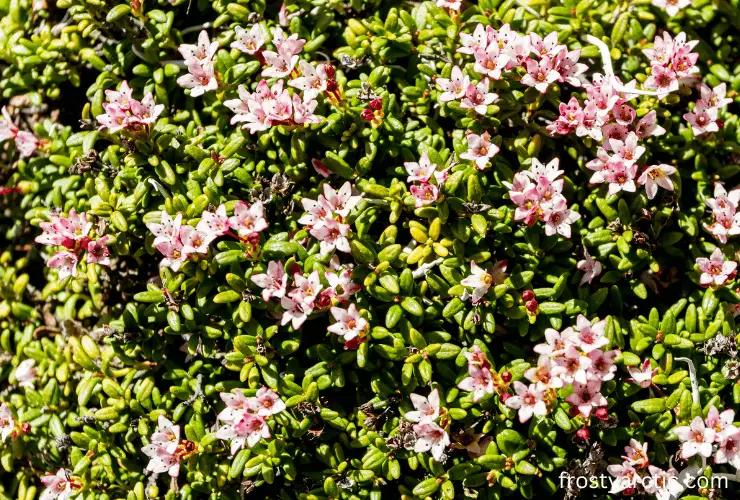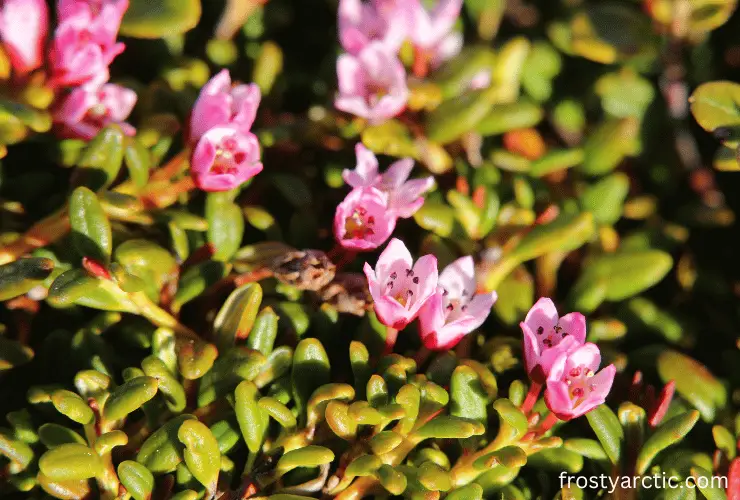Creeping Azalea is a mat-forming flowering plant that is found in high mountains. It contains poisonous parts, including flowers, leaves, fruits, and roots. The small flowers that appear pink in color are so attractive. Summer is the season when it blooms fully.
Throughout this article, I will provide every detail of Creeping Azalea as well as its advantages and disadvantages. You will also know the scientific use of this plant. If you want to grow this in your garden, you must read this article to the last word.
Creeping Azalea at a glance
| Parameters | Description |
| Scientific name | Kalmia procumbens |
| Plant type | Perennial |
| Plant size | 4-10 inch |
| Leaf size | Extremely small |
| Width | Extremely small |
| Soil condition | Acidic and wet |
| Watering | Average, don’t overwater |
| Sun exposure | Full |
| Leaf color | Green |
| Flower color | Pink |
| Blooming season | Late spring or summer |
| Toxicity | Highly toxic and poisonous |
What is a Creeping Azalea?
The scientific name of Creeping Azalea is Kalmia procumbens and it belongs to the Ericaceae family. Creeping Azalea is one type of perennial flowering plant that is usually found in Northern Hemisphere regions.
It is short in height or a dwarf shrub that has a maximum height of 10 cm. Normally, the height of these flowering plants range between 4 to 10 cm. Kalmia procumbens contains beautiful pink flowers that bloom in the late spring or in summer. The flowers appear bowl-shaped.

Moreover, this flowering plant provides fruits, and the shape of these fruits is spherical. The top of the leaves are dark green, and the underside of the leaves appears a white-brown color. This plant is also known as trailing azalea or Alpine azalea in various regions.
Why Is It Called Creeping Azalea?
To know the reason behind the naming of this flowering plant, first, you have to know the term “azalea.” Azalea is normally an English word. The term “azalea” came from the Greek word “azaleas,” which means dry.
The dry nature of the plants of this species is the main reason behind the naming of Azalea. On the other hand, when you see the Kalmia procumbens from a distance, you will see the plant creeping on the ground because of its short height.
Where Does Creeping Azalea Grow?
Creeping Azalea likes to grow in slightly acidic soil. Generally, sunny and wet ground is the best condition for the growth of this perennial plant. Though it likes sunny weather, it can tolerate under -45°C.
However, Creeping Azalea is most famous in Northern Hemisphere regions. Besides, it is also native to subarctic regions and North America. Usually, you will find them growing above the treeline in the Mountains.
How Do You Identify Creeping Azalea? [Appearance]

You can identify Creeping Azaleas easily by examining their physical characteristics. Here, I am mentioning some of the characteristics below:
- Height: Creeping azalea is very short in height. It is a dwarf shrub that is generally 4-10 cm tall.
- Flowers: Firstly, these plants contain pink flowers that are too attractive. Besides, the flowers are incredibly small that are 4 mm broad. Additionally, The shape of the flowers is like a bowl and has five stamens.
- Stems: As the height of the plant is small; thus it has a short woody stem. You can see that the stems are branched very densely.
- Leaves: In every node of the stem, there are two leaves. The leaves contain two types of colors. The upper side contains dark green, and the lower side has a white-down color. They are stalkless and oval-shaped. On edge, it doesn’t have any lobes.
- Fruits: You can easily identify the small fruits when you measure them and find 3-4 mm long fruits. Moreover, the fruits are spherical-shaped.
Creeping Azalea Adaptations
This plant evolved itself to adapt to its natural habitats. Those adaptations are:
- Small Size: Creeping Azalea adapts easily to harsh conditions for their growth type and size. The height is so small, and they grow very densely, which gives them the advantage of withstanding heavy winds.
- Warm Cushion: The cushion they make gives another advantage to survive in cold weather. Because the inside temperature is around 10 degrees Celsius warmer than the environmental temperature.
- Strong Roots: It has a strong root that goes deep into the earth’s ground. Thus, it gives the plant a strong base. Besides, it has a strong connection with fungal roots. For this reason, the fungal roots provide carbohydrates as Creeping Azalea food.
How Does Creeping Azalea Reproduce?
Creeping Azaleas can reproduce both sexually and asexually. Sexual reproduction is by seed, and asexual production happens after cutting.
- Sexual: Normally by seed. When the flowers drop and increase in size, the seeds are dropped on the ground. But not all the seeds are in good condition. The brown color seeds are best for this process.
Put these seeds into a container. After satisfying the result, sow the seeds into optimum condition. It will take 2-3 weeks to germinate. After waiting, it will develop its first leaves.
- Asexual: Branch layering is the most common asexual reproduction of Creeping azalea. Cut the underside of the branch and then bury it in the ground. Make sure that it is swallowed into the soil up to 3-4 inches. It will take a year or even more time to make the roots and then survive in the environment.
Is Creeping Azalea Edible?
No, Creeping Azalea is not edible for humans. Not only Creeping Azalea but also all types of azaleas are harmful to your health if you eat them. Because they contain poisonous components that can cause serious poisoning to humans as well as animals.
Flowers, leaves, roots, and even fruits; moreover, all parts of the plant are toxic. If you eat extreme amounts of any parts or honey made from the plant, it can take your life into a serious condition.
Creeping Azalea Taste
Creeping azalea tastes bitter. Though people do not eat the raw Kalmia procumbens, a small amount of sample was taken for the experiment in the laboratories to make sure that it is safe.
Mainly, Creeping Azalea contains grayanotoxin, which is extremely harmful. This poisonous flowering plant is not recommended to taste as it can throw your life in danger. Also, keep away any of the parts from animals.
Creeping Azalea Uses
Creeping Azalea has narrow uses in human life because of a toxic and poisonous plant. There is no food use for this plant. The flowers and the leaves may have some uses, though there is no evidence of it.
But this flowering plant has had a few medicinal uses since the old ages. It can cure various diseases and skin problems. But you have to use it as a doctor’s recommendation.
What Animals Eat Creeping Azalea?
All parts of creeping Azalea are toxic for humans as well as animals also. Cats, dogs, and other pets will have health problems if they eat any parts of a creeping azalea. The grayanotoxin causes diarrhea, vomiting, and walking difficulty in pets like animals.

Besides, Kalmia procumbens are also poisonous to wild animals. It can cause heart disease in horses and livestock. The leaf is the part that is the most detrimental for animals.
What Did Native Americans Use Creeping Azalea For?
The native Americans discovered the toxicity of this plant. Because it contains toxins, they refused to use it in any way. However, they discovered very few medicinal uses. But not a recommendation level. Eventually, they just used it to increase the beauty of the garden.
Is Creeping Azalea a Medicinal Plant? Medicinal Use Of Creeping Azalea
No, Creeping Azalea is not a common medicinal plant. It is a toxic plant that causes health damage to both humans and animals. However, some medicinal uses are available.
In some cases, the flowers are used as sedatives. Mainly, all medicinal applications of these plants are external. Typically, Creeping azalea treats itch and arthritis. Sometimes it can treat traumatic injuries also.
FAQs:
What is Creeping Azalea good for?
Creeping azalea is good for a few diseases like arthritis. But you can’t take it inside your body because this plant is so poisonous. To treat these problems, you have to use it externally.
What are other names for Creeping Azalea?
Creeping Azalea has different names in different regions. The other names are Trailing azalea, alpine azalea, and mountain azalea. The alpine azalea name is more famous in the alpine and tundra regions.
Can Creeping Azaleas grow in winter?
Yes, they can grow in winter. Creeping azalea loves to grow in sunny conditions. But they can grow in cold weather because the cushions keep the inside temperature higher than outside. It can withstand temperatures below -45°C.
Conclusion
Creeping Azalea grows in a wide range of areas in the world. But still, they are infamous. As it is a very poisonous plant, keep away children and pets from any parts of the plant. Though it has disadvantages, it has some medicinal uses. The best use is the increasing beauty of your garden. Eventually, attractive flowers can steal anyone’s heart.


